Cybersecurity in healthcare: How MSPs help safeguard patient data
Online Computers
MARCH 14, 2024
Many healthcare organizations can no longer function without relying on electronic health records (EHRs) and other technological advancements in healthcare. EHR and other healthcare tech tools make things faster and more efficient for healthcare providers. And how could they not?






























Let's personalize your content